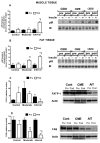Aerobic interval training versus continuous moderate exercise as a treatment for the metabolic syndrome: a pilot study
- PMID: 18606913
- PMCID: PMC2777731
- DOI: 10.1161/CIRCULATIONAHA.108.772822
Aerobic interval training versus continuous moderate exercise as a treatment for the metabolic syndrome: a pilot study
Abstract
Background: Individuals with the metabolic syndrome are 3 times more likely to die of heart disease than healthy counterparts. Exercise training reduces several of the symptoms of the syndrome, but the exercise intensity that yields the maximal beneficial adaptations is in dispute. We compared moderate and high exercise intensity with regard to variables associated with cardiovascular function and prognosis in patients with the metabolic syndrome.
Methods and results: Thirty-two metabolic syndrome patients (age, 52.3+/-3.7 years; maximal oxygen uptake [o(2)max], 34 mL x kg(-1) x min(-1)) were randomized to equal volumes of either moderate continuous moderate exercise (CME; 70% of highest measured heart rate [Hfmax]) or aerobic interval training (AIT; 90% of Hfmax) 3 times a week for 16 weeks or to a control group. o(2)max increased more after AIT than CME (35% versus 16%; P<0.01) and was associated with removal of more risk factors that constitute the metabolic syndrome (number of factors: AIT, 5.9 before versus 4.0 after; P<0.01; CME, 5.7 before versus 5.0 after; group difference, P<0.05). AIT was superior to CME in enhancing endothelial function (9% versus 5%; P<0.001), insulin signaling in fat and skeletal muscle, skeletal muscle biogenesis, and excitation-contraction coupling and in reducing blood glucose and lipogenesis in adipose tissue. The 2 exercise programs were equally effective at lowering mean arterial blood pressure and reducing body weight (-2.3 and -3.6 kg in AIT and CME, respectively) and fat.
Conclusions: Exercise intensity was an important factor for improving aerobic capacity and reversing the risk factors of the metabolic syndrome. These findings may have important implications for exercise training in rehabilitation programs and future studies.
Trial registration: ClinicalTrials.gov NCT00218998.
Figures



Comment in
-
Letter by Poelkens et al regarding article, "Aerobic interval training versus continuous moderate exercise as a treatment for the metabolic syndrome: a pilot study".Circulation. 2009 Mar 3;119(8):e225; author reply e226. doi: 10.1161/CIRCULATIONAHA.108.818765. Circulation. 2009. PMID: 19255350 No abstract available.
References
-
- Grundy SM, Brewer HB, Jr., Cleeman JI, Smith SC, Jr., Lenfant C. Definition of metabolic syndrome: Report of the National Heart, Lung, and Blood Institute/American Heart Association conference on scientific issues related to definition. Circulation. 2004;109:433–438. - PubMed
-
- James PT, Rigby N, Leach R. The obesity epidemic, metabolic syndrome and future prevention strategies. Eur J Cardiovasc Prev Rehabil. 2004;11:3–8. - PubMed
-
- Lakka HM, Laaksonen DE, Lakka TA, Niskanen LK, Kumpusalo E, Tuomilehto J, Salonen JT. The metabolic syndrome and total and cardiovascular disease mortality in middle-aged men. Jama. 2002;288:2709–2716. - PubMed
-
- Halcox JP, Schenke WH, Zalos G, Mincemoyer R, Prasad A, Waclawiw MA, Nour KR, Quyyumi AA. Prognostic value of coronary vascular endothelial dysfunction. Circulation. 2002;106:653–658. - PubMed
-
- Myers J, Prakash M, Froelicher V, Do D, Partington S, Atwood JE. Exercise capacity and mortality among men referred for exercise testing. The New England journal of medicine. 2002;346:793–801. - PubMed
Publication types
MeSH terms
Associated data
Grants and funding
LinkOut - more resources
Full Text Sources
Medical
Miscellaneous

